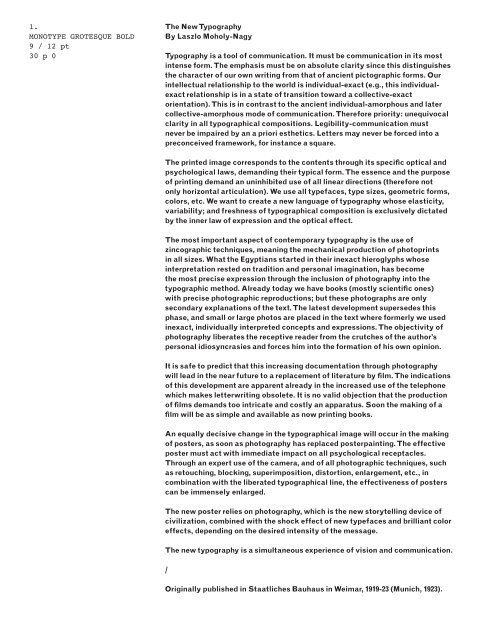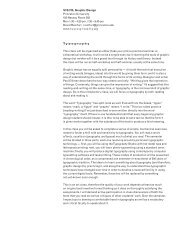Download the PDF here. - typography
Download the PDF here. - typography
Download the PDF here. - typography
Create successful ePaper yourself
Turn your PDF publications into a flip-book with our unique Google optimized e-Paper software.
1.<br />
MONOTYPE GROTESQUE BOLD<br />
9 / 12 pt<br />
30 p 0<br />
The New Typography<br />
By Laszlo Moholy-Nagy<br />
Typography is a tool of communication. It must be communication in its most<br />
intense form. The emphasis must be on absolute clarity since this distinguishes<br />
<strong>the</strong> character of our own writing from that of ancient pictographic forms. Our<br />
intellectual relationship to <strong>the</strong> world is individual-exact (e.g., this individualexact<br />
relationship is in a state of transition toward a collective-exact<br />
orientation). This is in contrast to <strong>the</strong> ancient individual-amorphous and later<br />
collective-amorphous mode of communication. T<strong>here</strong>fore priority: unequivocal<br />
clarity in all typographical compositions. Legibility-communication must<br />
never be impaired by an a priori es<strong>the</strong>tics. Letters may never be forced into a<br />
preconceived framework, for instance a square.<br />
The printed image corresponds to <strong>the</strong> contents through its specific optical and<br />
psychological laws, demanding <strong>the</strong>ir typical form. The essence and <strong>the</strong> purpose<br />
of printing demand an uninhibited use of all linear directions (<strong>the</strong>refore not<br />
only horizontal articulation). We use all typefaces, type sizes, geometric forms,<br />
colors, etc. We want to create a new language of <strong>typography</strong> whose elasticity,<br />
variability; and freshness of typographical composition is exclusively dictated<br />
by <strong>the</strong> inner law of expression and <strong>the</strong> optical effect.<br />
The most important aspect of contemporary <strong>typography</strong> is <strong>the</strong> use of<br />
zincographic techniques, meaning <strong>the</strong> mechanical production of photoprints<br />
in all sizes. What <strong>the</strong> Egyptians started in <strong>the</strong>ir inexact hieroglyphs whose<br />
interpretation rested on tradition and personal imagination, has become<br />
<strong>the</strong> most precise expression through <strong>the</strong> inclusion of photography into <strong>the</strong><br />
typographic method. Already today we have books (mostly scientific ones)<br />
with precise photographic reproductions; but <strong>the</strong>se photographs are only<br />
secondary explanations of <strong>the</strong> text. The latest development supersedes this<br />
phase, and small or large photos are placed in <strong>the</strong> text w<strong>here</strong> formerly we used<br />
inexact, individually interpreted concepts and expressions. The objectivity of<br />
photography liberates <strong>the</strong> receptive reader from <strong>the</strong> crutches of <strong>the</strong> author’s<br />
personal idiosyncrasies and forces him into <strong>the</strong> formation of his own opinion.<br />
It is safe to predict that this increasing documentation through photography<br />
will lead in <strong>the</strong> near future to a replacement of literature by film. The indications<br />
of this development are apparent already in <strong>the</strong> increased use of <strong>the</strong> telephone<br />
which makes letterwriting obsolete. It is no valid objection that <strong>the</strong> production<br />
of films demands too intricate and costly an apparatus. Soon <strong>the</strong> making of a<br />
film will be as simple and available as now printing books.<br />
An equally decisive change in <strong>the</strong> typographical image will occur in <strong>the</strong> making<br />
of posters, as soon as photography has replaced posterpainting. The effective<br />
poster must act with immediate impact on all psychological receptacles.<br />
Through an expert use of <strong>the</strong> camera, and of all photographic techniques, such<br />
as retouching, blocking, superimposition, distortion, enlargement, etc., in<br />
combination with <strong>the</strong> liberated typographical line, <strong>the</strong> effectiveness of posters<br />
can be immensely enlarged.<br />
The new poster relies on photography, which is <strong>the</strong> new storytelling device of<br />
civilization, combined with <strong>the</strong> shock effect of new typefaces and brilliant color<br />
effects, depending on <strong>the</strong> desired intensity of <strong>the</strong> message.<br />
The new <strong>typography</strong> is a simultaneous experience of vision and communication.<br />
/<br />
Originally published in Staatliches Bauhaus in Weimar, 1919-23 (Munich, 1923).




